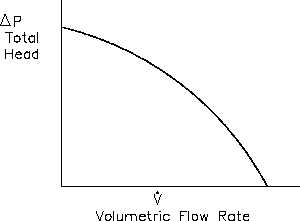CENTRIFUGAL PUMPS
Fluid Flow
Operating Characteristics of a Centrifugal Pump
Normally, a centrifugal pump produces a relatively low pressure increase in the fluid. This
pressure increase can be anywhere from several dozen to several hundred psid across a
centrifugal pump with a single stage impeller. The term PSID (Pounds Force Per Square Inch
Differential) is equivalent to DP. In this context, it is the pressure difference between the suction
and discharge of a pump. PSID can also be used to describe a pressure drop across a system
component (strainers, filters, heat exchangers, valves, demineralizers, etc.). When a centrifugal
pump is operating at a constant speed, an increase in the system back pressure on the flowing
stream causes a reduction in the magnitude of volumetric flow rate that the centrifugal pump can
maintain.
Figure 7 Typical Centrifugal Pump
Characteristic Curve
Analysis of the relationship between the
volumetric flow rate ( ) that a centrifugal
V
pump can maintain and the pressure
differential across the pump (DPpump) is
based on various physical characteristics of
the pump and the system fluid. Variables
evaluated by design engineers to determine
this relationship include the pump efficiency,
the power supplied to the pump, the
rotational speed, the diameter of the impeller
and blading, the fluid density, and the fluid
viscosity. The result of this complicated
analysis for a typical centrifugal pump
operating at one particular speed is
illustrated by the graph in Figure 7.
Pump head, on the vertical axis, is the
difference between system back pressure and the inlet pressure of the pump (DPpump). Volumetric
flow rate ( ), on the horizontal axis, is the rate at which fluid is flowing through the pump. The
V
graph assumes one particular speed (N) for the pump impeller.
Cavitation
When the liquid being pumped enters the eye of a centrifugal pump, the pressure is significantly
reduced. The greater the flow velocity through the pump the greater this pressure drop. If the
pressure drop is great enough, or if the temperature of the liquid is high enough, the pressure
drop may be sufficient to cause the liquid to flash to steam when the local pressure falls below
the saturation pressure for the fluid that is being pumped. These vapor bubbles are swept along
the pump impeller with the fluid. As the flow velocity decreases the fluid pressure increases.
This causes the vapor bubbles to suddenly collapse on the outer portions of the impeller. The
formation of these vapor bubbles and their subsequent collapse is cavitation.
HT-03
Page 48
Rev. 0


